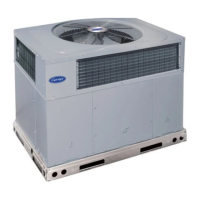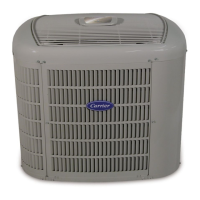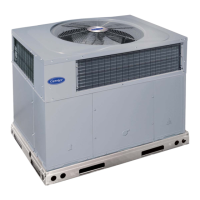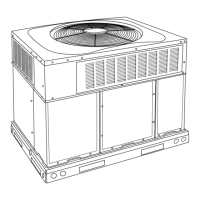PGD4, PGS4, Series G, H WPG4 Series D, H Ultra Low NOx: Installation Instructions
Manufacturer reserves the right to change, at any time, specifications and designs without notice and without obligations.
16
A180078
Fig. 13 – Burner Assembly
A200293
Fig. 14 – BurnerBox/Gas Manifold Assembly
Check Heating Control
Start and check the unit for proper heating control operation as follows
(see furnace lighting instructions located on the inside of the control
access panel):
1. Place room thermostat SYSTEM switch in the HEAT position and
the fan switch is placed in AUTO position.
2. Set the heating temperature control of the thermostat above room
temperature.
3. The induced-draft motor will start.
4. On a call for heating, the main burner should light within 5 sec. of
the spark being energized. If the burners do not light, there is a
22-sec. delay before another 5-sec. try. If the burners still do not
light, this sequence is repeated. If the burners do not light on the 4th
ignition attempt, there is a lockout. To reset the control, break the
24-v power to W.
5. The evaporator fan will turn on 30 sec. after the flame has been
established. The evaporator fan will turn off 90 sec. after the
thermostat has been satisfied. Please note that the integrated gas
unit controller (IGC) has the capability to automatically reduce the
evaporator “ON” delay and increase the evaporator “OFF” delay in
the event of high duct static and/or partially-clogged filter.
Check Gas Input
Check gas input and manifold pressure after unit start-up (See Table 5).
If adjustment is required proceed as follows:
• The rated gas inputs shown in Table 5 are for altitudes from sea level
to 2000 ft (610 m) above sea level. These inputs are based on natural
gas with a heating value of 1025 Btu/ft
3
at 0.60 specific gravity.
When the gas supply being used has a different heating value or specific
gravity, refer to national and local codes, or contact your distributor to
determine the required orifice size.
Adjust Gas Input
The gas input to the unit is determined by measuring the gas flow at the
meter or by measuring the manifold pressure. Measuring the gas flow at
the meter is recommended for natural gas units. Measure Gas Flow
(Natural Gas Units)
Minor adjustment to the gas flow can be made by changing the manifold
pressure. The manifold pressure must be maintained between 3.2 and 3.8
IN. W.C.
A07751
Fig. 15 – Standard Single-Stage Gas Valve
A170118
Fig. 16 – Single-Stage Gas Valve with Tower Pressure Ports
Table 3 – Altitude Derate Multiplier for U.S.A.
*
*. In Canada see Canadian Altitude Adjustment.
Altitude ft
†
(m)
†. Altitude of 2001 ft and above is not allowed.
Percent of Derate
Derate Multiplier
Factor
‡
‡. Derate multiplier factors are based on midpoint altitude for altitude range.
0-2000
(0-610)
0 1.00
WARNING
!
UNIT DAMAGE HAZARD
Failure to follow this caution may result in reduced unit and/or
component life.
Do Not redrill an orifice. Improper drilling (burrs, out-of-round holes,
etc.) can cause excessive burner noise and misdirection of burner flame.
If orifice hole appears damaged or it is suspected to have been redrilled,
check orifice hole with a numbered drill bit of correct size.
REGULATOR
COVER SCREW
ADJUSTMENT
SCREW
REGULATOR SPRING
(PROPANE - WHITE)
NATURAL - SILVER)
GAS PRESSURE
REGULATOR
ADJUSTMENT
MANIFOLD
PRESSURE TAP
INLET
PRESSURE TAP
ON/OFF SWITCH
PLASTIC
(

